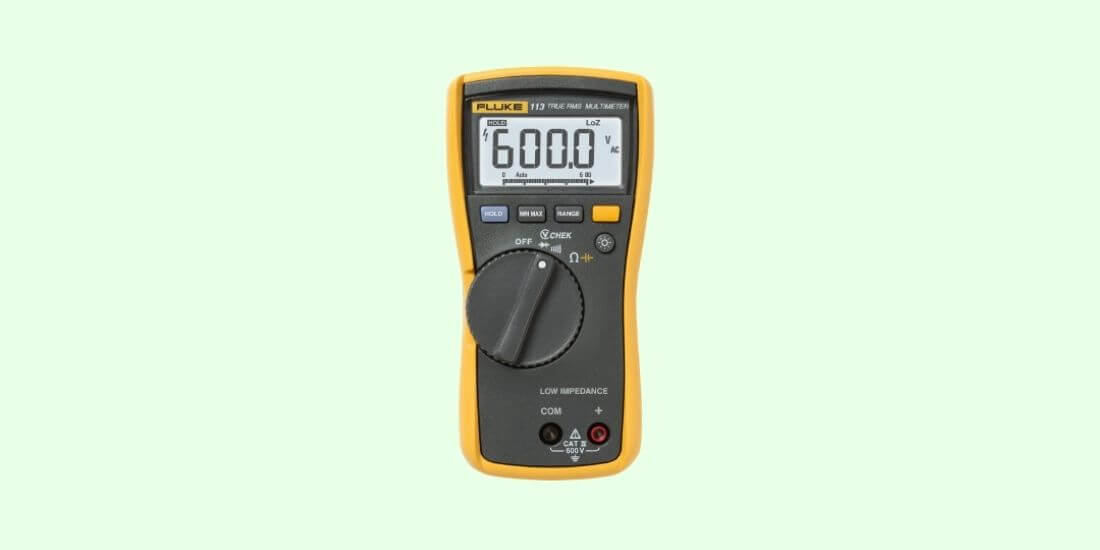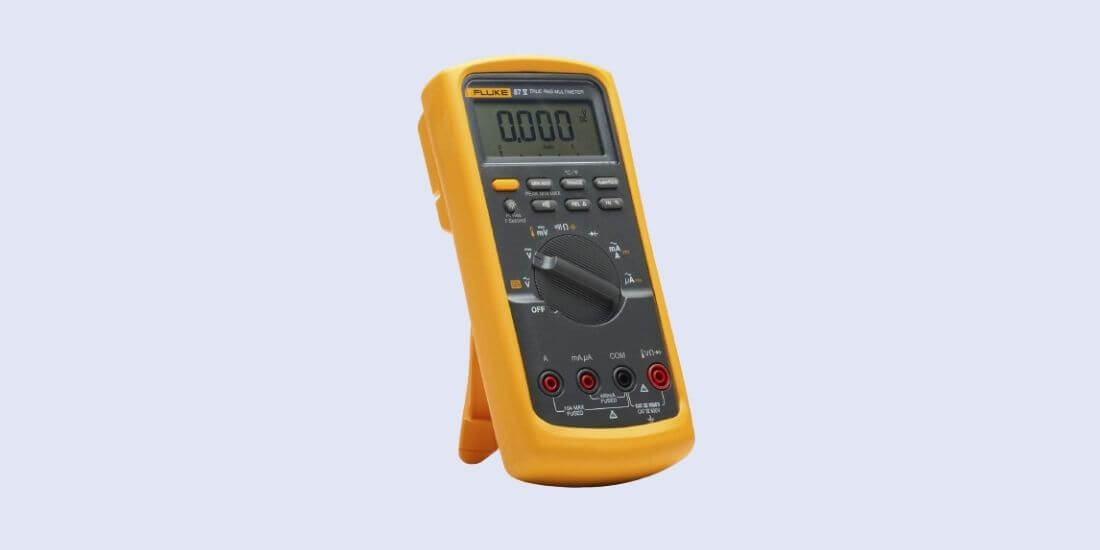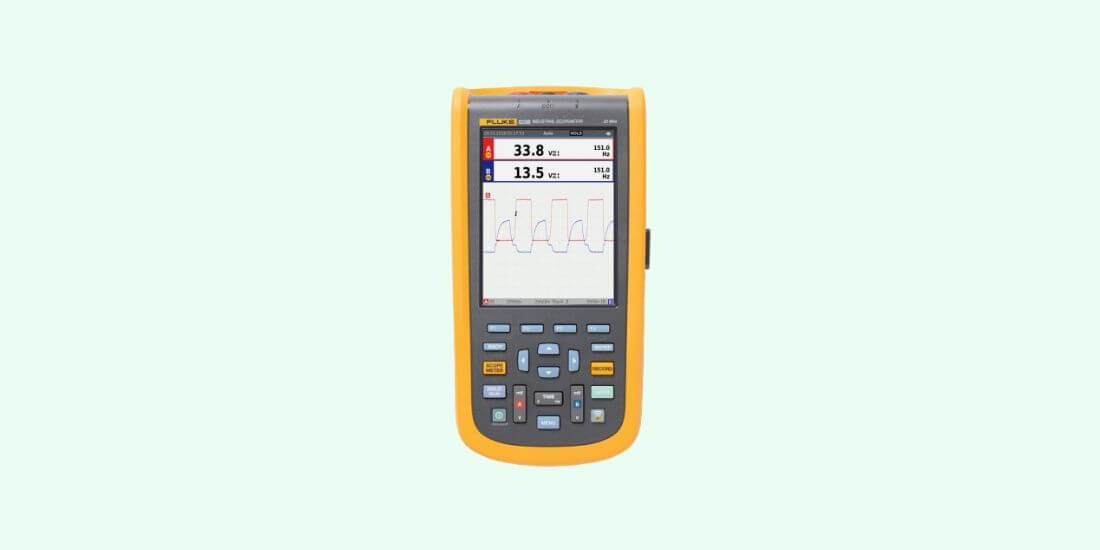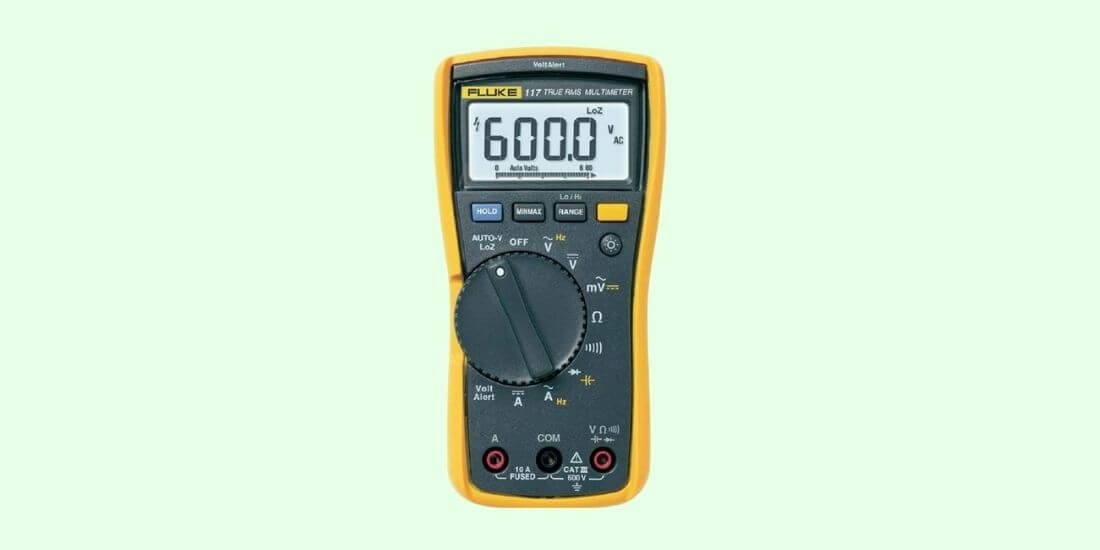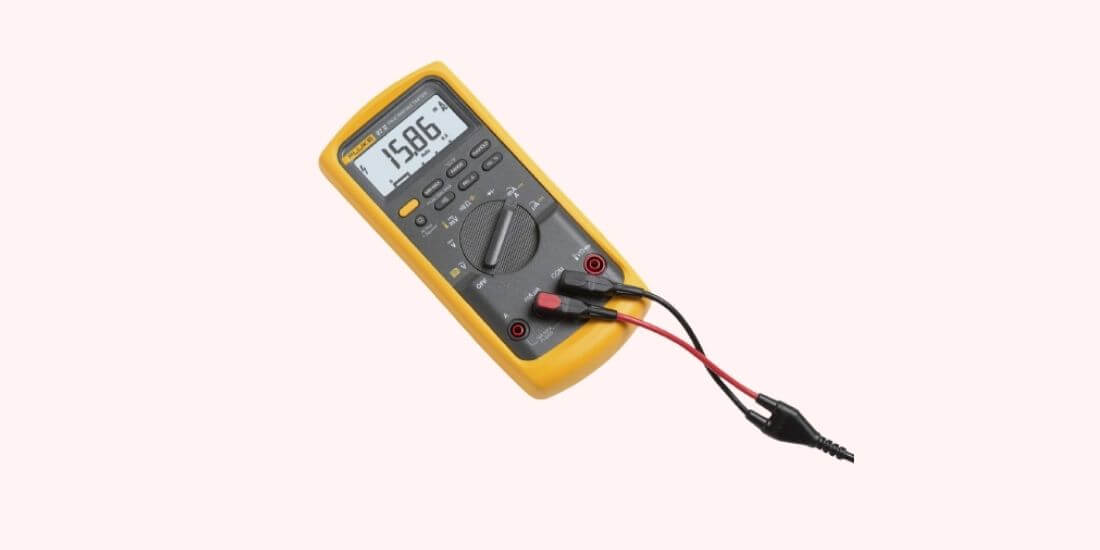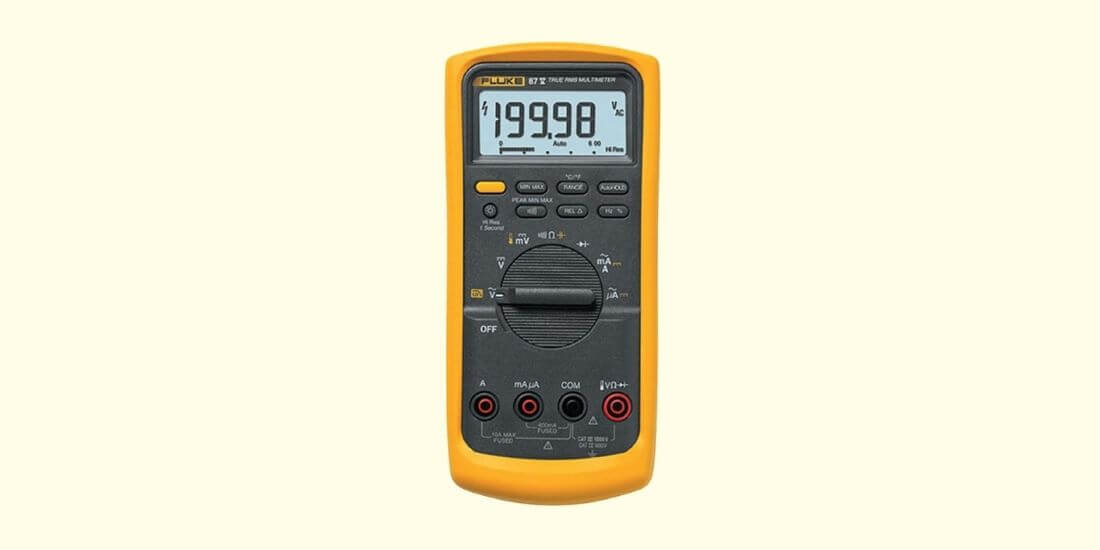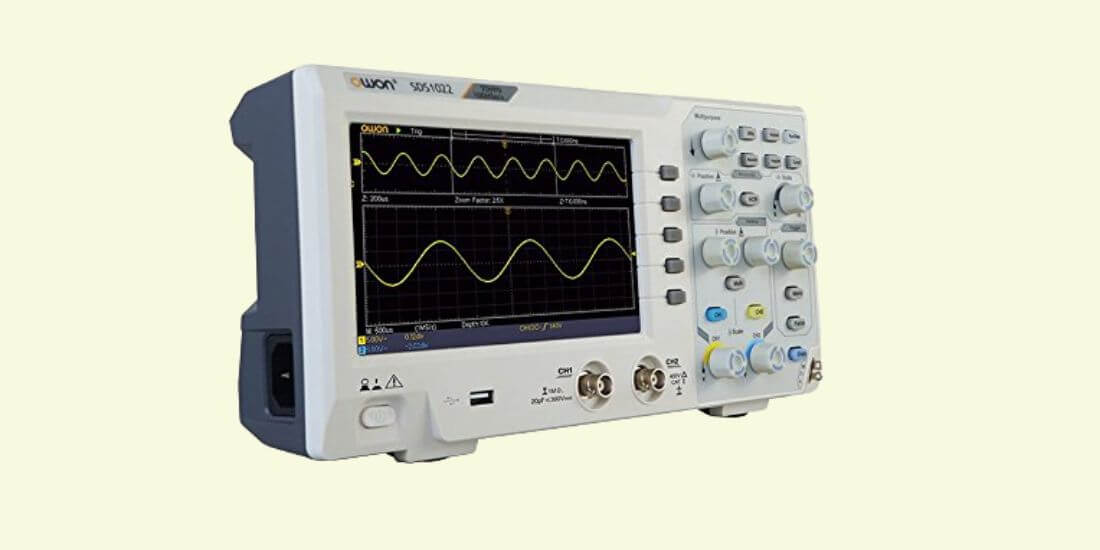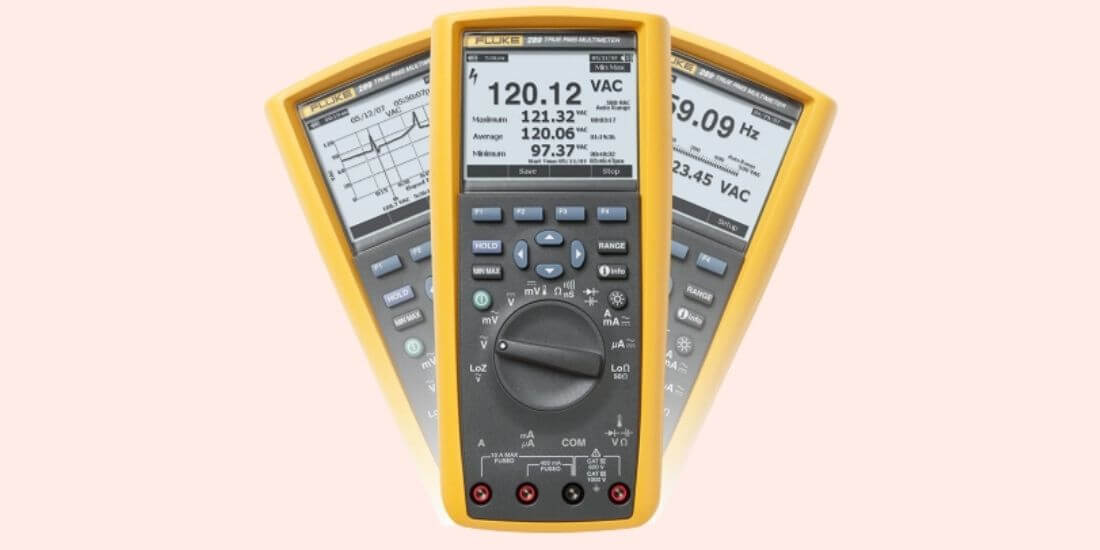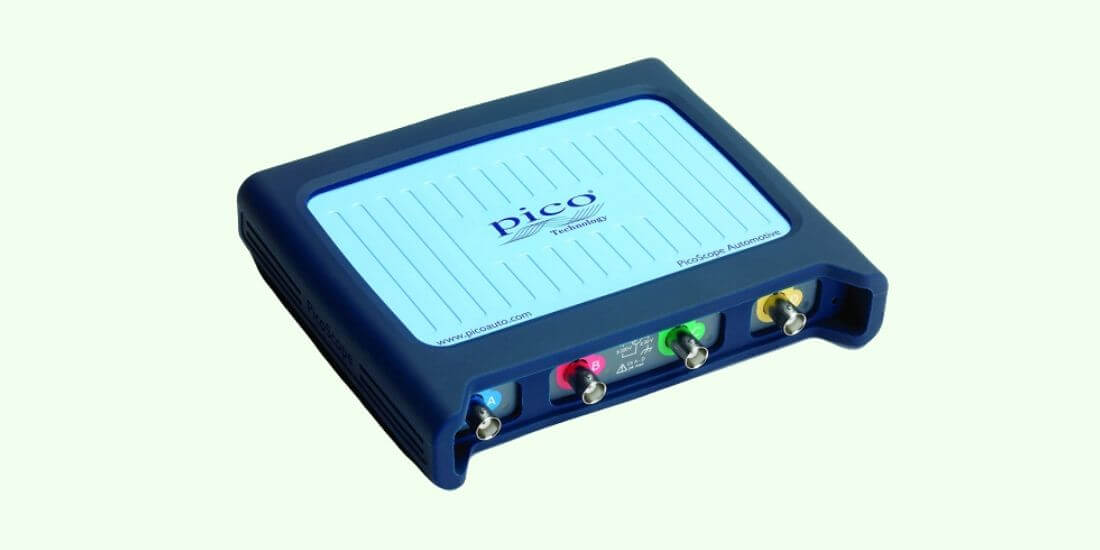True-RMS multimeters can be handy tools that serve multiple purposes at once.
They include many practical functions that make them a must-have for anyone measuring voltage, resistance, and other variables for their work.
In this case, Fluke is a very popular choice- you will be getting all the functions necessary at a very affordable price, along with top-notch accuracy and reliability.
But to make the best out of it, you will need to choose the most suitable device for you.
Hence, in our fluke 113 vs 114 vs 115 vs 116 vs 117 comparison article, we have reviewed all of them separately while mentioning their fundamental differences.
All of the five devices are stunning in their own ways, but one would surely be more apt for you than the others- and this article will help you find that one.
So without further delay, let’s start the search.
Fluke 113 vs 114 vs 115 vs 116 vs 117 Comparison
Last update on 2025-05-29 / Affiliate links / Images from Amazon Product Advertising API
1. Fluke 113

It’s often difficult to find multimeters that provide excellent value for money.
However, here’s one that does, as it contains various stunning features that make it worth the investment. Find out more about its aspects in our comprehensive review.
You will be able to get a lot done using this one device only. It comes with several functions and can measure multiple variables.
For instance, the meter can measure resistance, capacitance, and AC/DC voltage and perform diode and continuity tests.
When it comes to accuracy, this is one tool you can rely on without any doubt.
The device provides accurate readings while measuring both linear and non-linear loads. It does so where the current and the voltage have both sinusoidal and non-sinusoidal waveforms.
The meter contains other handy features as well that really make it unmatched in the market.
For instance, the device is capable of checking the continuity and voltage at the same time. Hence, you won’t have to compromise at all when making measurements.
On the other hand, this device keeps versatility along with your flexibility in mind. That is why it comes with auto and manual ranging modes.
This aspect will let you make measurements in various ways, which will bring more versatility to your work.
Moreover, you will be able to go through the readings quite effortlessly, thanks to its large backlit display, which will let you view the values in poorly lit areas.
Furthermore, the meter comes with safety ratings of 600V and 300V, so you won’t have to worry about your security.
However, the device fails to measure static voltages accurately, which might bring some restrictions to your work. On the other hand, you will have to calibrate the meter by yourself, or else it will not work properly.
PROS
- Measures resistance, capacitance, AC/DC voltage and performs tests
- Offers accurate readings while measuring linear/non-linear loads
- Checks for continuity and voltage at the same time
- Auto and manual ranging modes ensure user flexibility
- Comes with safety ratings of 600V and 300V and a large backlit display
CONS
- Fails to measure static voltages accurately
- Won’t work properly unless calibrated
Latest Guide: Fluke 189 vs 289
2. Fluke 114

If you have never used a multimeter before, then you will surely need one that doesn’t contain complicated functions.
And here’s good news for you— this device is effortless to use and totally suitable for beginners. Find out more about its impressive facilities here.
Multimeters can be used for various functions- one of which can be following a trend between the measurements.
To make that task even easier, this device can record fluctuations in a signal using min, max, and average. Hence, you won’t have to put in any extra effort.
Furthermore, you will be able to read all the values conveniently, thanks to its white and large LED display.
The display includes a backlight, which will allow you to work in dark environments as well. So you won’t have to worry about your workplace having low light.
What makes the device even better is that it will prohibit false readings at all times.
Sometimes, meters show false values due to ghost voltages, but the low input impedance of this device will make sure that does not happen-providing accurate readings continuously.
To make your work even more convenient for you, the meter includes a function that offers AC/DC voltage selection.
This feature makes the selection automatic, so the device will know best as to when which one should be selected. So you can just save your effort.
Another beneficial facility of this multimeter is that it includes a function that will keep track of continuity and resistance simultaneously.
Therefore, you won’t have to go through the hassle of checking each individually— as the meter already takes care of that.
But the device lacks some functions, which can disappoint the users. For instance, it does not include the diode test function.
On the other hand, the quality of the construction may seem a little cheap, which can be unpleasant for the users.
PROS
- Can record fluctuations in a signal using min, max, and average
- Includes a white LED-backlit display that is large
- Prohibits false readings by ghost voltages using low input impedance
- Offers AC/DC voltage selection that is automatic
- Simultaneously keeps track of continuity and resistance
CONS
- Does not include certain functions such as the diode test one
- Construction might seem a little cheap
3. Fluke 115

The primary task of a multimeter is to provide accurate readings, and if it fails to do so, then should you even get that device?
Well, here’s a meter that provides top-notch accuracy at all times, which makes it reliable. Find out more about its functions in our comprehensive review.
You will be able to measure multiple variables using this one device only— which prevents the need for getting other similar devices.
It can check frequency, continuity, and capacitance and also perform diode tests. Therefore, you can get it all done using this.
On the other hand, you won’t have to worry about whether or not the meter is safe to use because it already comes with a safety rating.
Furthermore, the device includes an operating temperature of -10-50C so that you can use it in both extremely cold and warm conditions.
What makes the multimeter even better is that it can measure 10A of current continuously, without any pauses whatsoever.
Moreover, it can measure up to 20A of current, but that will contain 30 seconds of break— which would still provide fast results.
Are you worried about being unable to work in low light conditions? Well, with this device at hand, you should stop fretting right away.
It comes with a large and white LED backlit display, which will not only make the readings clear but will also let you view them when there are no surrounding lights.
The meter contains several functions that make it a reliable one. For instance, it can measure non-linear loads quite accurately.
Hence, you can depend on it to give precise readings at all times.
One of the major drawbacks of this product is that it comes with a stiff dial, which is difficult to move. So you will require some extra energy for that.
On the other hand, it is impossible to zero the meter, which increases the possibility of receiving false readings.
PROS
- Checks frequency, continuity, capacitance and diode test
- Safety rated and has an operating temperature of -10-50C
- Measures 20A with 30 seconds momentary and 10A continuous
- Includes a large and white LED backlit display
- Measures non-linear loads precisely
CONS
- Dial is very stiff and difficult to move
- Impossible to zero the meter
Related Guide: Hobbyist Benchtop Power Supply
4. Fluke 116

Using a multimeter is no rocket science, but it does require some knowledge and experience if you are using one with complicated functions.
However, here’s a meter that includes simple features, which makes it very simple to operate. Find out more about its stunning aspects here.
This device contains a function that sets it apart from the rest of its counterparts- and that is, it comes with the unit microamps.
The benefit of this certain feature is that it will allow you to test flame sensors, which often cannot be done using other multimeters.
When it comes to accuracy, this device doesn’t fall behind, either. The meter contains low input impedance, which prohibits false readings.
Sometimes, such devices show false readings due to ghost voltage— but that is not something you will have to worry about with this one.
Another facility that makes this device particularly unique is that you can use it for HVAC applications as well. For that purpose, the product contains a built-in thermometer.
As a result, you won’t have to buy and carry one separately, because this meter will give you temperature measurements anyway.
Other than that, the tool can measure several variables without any hassle whatsoever. For instance, it is capable of measuring capacitance, continuity, resistance, and frequency.
Hence, you won’t have to purchase another similar device because you can get everything done through this.
What makes the tool even better is that you will be able to view the readings in the dark as well.
That is because the meter contains a white and large LED backlit display, which will allow you to work in low light conditions as well without the need for a torchlight.
But the built-in thermometer included can be inaccurate at times- so you won’t be able to rely on the temperature measurements now and then.
Moreover, the description of the product mentions that it contains a holster, but it actually does not, which is quite deceiving.
PROS
- Microamps included to test flame sensors
- Prohibits false readings by ghost voltage using low input impedance
- Suitable for HVAC applications due to the built-in thermometer
- Measures capacitance, continuity, resistance, and frequency
- White and large LED backlit display
CONS
- Temperature measurement can be inaccurate at times
- Does not include a holster even though the description says it does
5. Fluke 117

To get the best out of your multimeter, you will need to make sure that you are reading it accurately.
For that, you need one that is easy to read— and this device contains exactly that facility. Along with that, it is also effortless to use and contains a lot more commendable features.
First of all, the meter allows non-linear loads to be measured accurately under an operating temperature of -10-50C.
As a result, you will be able to use this device in both extremely cold and warm conditions. This aspect will allow you to work in any season.
Not only that, you can work in low light conditions as well, while viewing all the readings clearly. For that, this device includes a white and large backlit LED display.
Moreover, the battery of the meter can last up to 400 hours if the backlight is off, so you don’t have to worry about charging it now and then.
You also won’t have to worry about ghost voltages providing false readings from time to time.
That is because the device includes low input impedance, which will make sure you get precise and accurate readings at all times.
What sets this device apart from the rest of its counterparts is its VoltAlert technology.
The benefit of this feature is that it detects voltage without any sort of contact, so you will be getting updates as long as the multimeter is on.
Other than that, the device measures several variables, which makes it really handy for the users. For instance, it can measure continuity, capacitance, resistance, and frequency without any trouble whatsoever.
However, the display of the device has a very narrow-angled view, which may provide difficulty in readings the values from time to time.
On the other hand, the backlit display isn’t very bright so that you may require an extra source of light in low light conditions.
PROS
- Measures non-linear loads accurately with an operating temperature of -10-50°C
- Includes a white and large backlit LED display with 400 hours battery life
- Prevents false readings by ghost voltage using low input impedance
- VoltAlert technology allows voltage detection without contact
- Measures continuity, capacitance, resistance and frequency
CONS
- Display has a very narrow-angled view
- Backlit display isn’t very bright
Fluke 113 or 114 or 115 or 116 or 117 Digital Multimeter?
Last update on 2025-05-29 / Affiliate links / Images from Amazon Product Advertising API
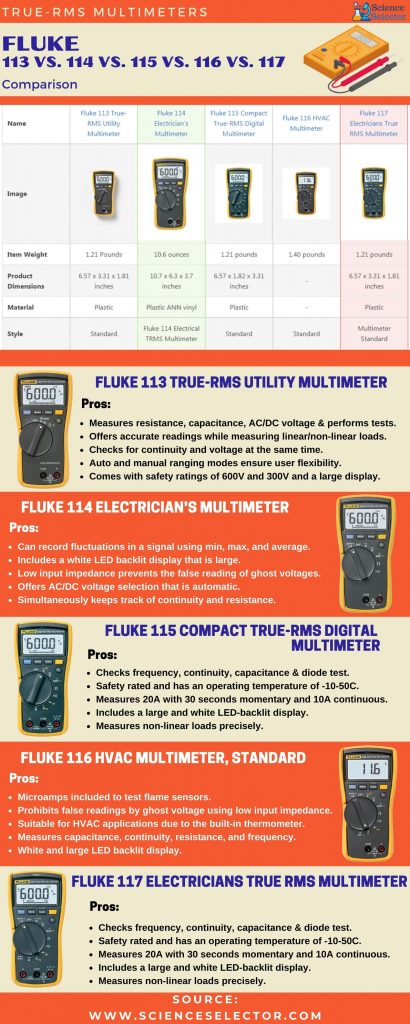
When looking for a true-RMS meter, fluke 113, 114, 115, 116 and 117 are the 5 options that you can consider reliably.
However, these 5 devices are very similar, making it difficult for just about anyone to choose one.
But in this section of the article, we will be discussing some of the significant differences among these tools, which will make it easier for you to select one.
Once you go through the differences, you will be able to know more about which one is more suitable for you.
Functions
All of the five versions of Fluke true-RMS multimeter contain various user-oriented functions that make them handy for the users. However, some include extra functions whereas others may lack a few.
For instance, you can record the signal fluctuations of 113 and 114, whereas others lack this feature. On the other hand, 113 and 115 can perform diode and other forms of tests.
Moreover, 117 allows voltage detection without contact, while 116 includes a built-in thermometer and the microamps unit.
Furthermore, 114 can select AC/DC voltage automatically, and 113 provides auto and manual ranging modes.
So, even though the basic functions of these devices are quite similar, they do contain various features that set them apart.
Display
When it comes to the display, all of the devices mentioned are quite similar. They come with a white and large backlit display, which will allow you to see the readings quite clearly and let you work in low light conditions with ease.
However, the 117 version is a little behind in this sector. Its display offers a very narrow-angled view, which its users may find it difficult to work with. On the other hand, its backlight isn’t very bright as well.
But the rest four top-notch display indiscriminately — so you won’t have to worry much about this aspect.
Accuracy
Of course, all of the multimeters reviewed here provide excellent accuracy or else they wouldn’t be well known and considered by multiple customers. Hence, you won’t find one that is somehow more accurate and precise.
But some do contain certain features that increase their accuracy or make them more reliable. For instance, 114, 116 and 117 come with low input impedance, which prevents the device from giving false readings because of ghost voltage.
As a result, these three versions can be regarded as more accurate, simply because they will guarantee correct readings at all times. Other than that, you can trust all of the five multimeters to be precise and accurate.
Ease of Use
None of the multimeters mentioned contains complicated functions and features, which would make it difficult for you to operate the device.Hence, in a sense, all of them are quite convenient to use.
But if you are a beginner and looking for something that would make things simpler for you, then you can rely on 114, 116, and 117. These contain straightforward functions, which would be apt for an amateur.
113 and 115 aren’t challenging to use either; however, those two versions are more suitable for professionals or experienced users rather than beginners. We would suggest going through the directions before you start using any of these tools.
Value for Money
One of the major benefits of Fluke true-RMS multimeters is that all of them are affordable, and you won’t have to splurge a lot to get a brand new one.
But if you have to choose one that provides excellent value for money according to all the features that it comes with, then you should surely go for 113. All of its facilities really make it worth the investment.
Now, about the rest, they too provide good value for money, given you will be getting a lot of facilities in an affordable price range. So you could say that no matter which one you invest in, it would surely be worth it.
Last update on 2025-05-29 / Affiliate links / Images from Amazon Product Advertising API
Frequently Asked Questions
Do all true-RMS meters include a built-in thermometer?
True-RMS multimeters aren’t meant to have built-in thermometers- simply because people don’t buy them to measure temperatures, but some can include one.
For instance, among the five multimeters compared in this article, the 116 version contains one, unlike the others.
Which meter costs the least among these five?
Among all the five meters, the 113 version is the least expensive and it also provides excellent value for money.
On the other hand, the 117 version is the most expensive. However, the price of these two doesn’t differ much from the rest of its counterparts.
What is a true-RMS multimeter?
The aspect that sets true-RMS multimeters apart from its other counterparts is that it measures the heating potential of an applied voltage. The task of this tool is to determine the power that is dissipated in a resistor.
Do I need a large display with a true-RMS multimeter?
You won’t necessarily need a large display with a true-RM multimeter, but it will surely be beneficial if you get one.
That is because, it will allow you to view the readings more clearly, and it will also show more numbers and values on the screen.
As a beginner, which meter should I choose among these?
As a beginner, you will need a meter that is effortless to use. And you will find such facilities in 114, 116 and 117. Others are quite simple to use as well, but these three are fit for amateurs.
Fluke 113 vs Fluke 114 vs Fluke 115 vs Fluke 116 vs Fluke 117
The five versions of Fluke true-RMS multimeters are quite similar as well as different. And we hope that after going through our Fluke 113 vs 114 vs 115 vs 116 vs 117 comparison, you should be clear about their differences.
Although all of them are excellent and reliable, one will surely prove to be better than the rest for your work. So don’t give up until you find that one.
Last update on 2025-05-29 / Affiliate links / Images from Amazon Product Advertising API
-
Digital multimeters can be used to measure multiple electrical variables, which can benefit both amateurs…
-
Oscilloscopes have become an integral part of all sorts of industries, from the telecommunication and…
-
Suppose you've got two devices right there on your table. One of them came from…
-
Unless you are a technician who needs to alternate between True RMS and automotive meters,…
-
Changing a lightbulb is no rocket science, but thanks to the Internet, we can fix…
-
If you’re looking for incredible oscilloscopes worth every bit of money invested, you’ll most likely…
-
Are you looking for a multimeter that can measure AC voltage indefinitely? In that case,…
-
Currently, you can find a large variety of digital oscilloscopes available in the market. The…

